CREATE TABLE roles_users2 LIKE roles_users; -- this ensures indexes are preserved
INSERT INTO roles_users2 SELECT DISTINCT * FROM roles_users;
DROP TABLE roles_users;
RENAME TABLE roles_users2 TO roles_users;
and for the future, to prevent duplicate rows
ALTER TABLE roles_users ADD UNIQUE INDEX (role_id, user_id);
Or, you can do all of it in one step with ALTER TABLE IGNORE:
ALTER IGNORE TABLE roles_users ADD UNIQUE INDEX (role_id, user_id);
IGNORE is a MySQL extension to standard SQL. It controls how ALTER TABLE works if there are duplicates on unique keys in the new table or if warnings occur when strict mode is enabled. If IGNORE is not specified, the copy is aborted and rolled back if duplicate-key errors occur. If IGNORE is specified, only the first row is used of rows with duplicates on a unique key. The other conflicting rows are deleted. Incorrect values are truncated to the closest matching acceptable value.
